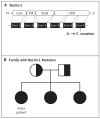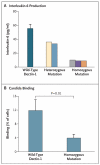Human dectin-1 deficiency and mucocutaneous fungal infections
- PMID: 19864674
- PMCID: PMC2773015
- DOI: 10.1056/NEJMoa0901053
Human dectin-1 deficiency and mucocutaneous fungal infections
Abstract
Mucocutaneous fungal infections are typically found in patients who have no known immune defects. We describe a family in which four women who were affected by either recurrent vulvovaginal candidiasis or onychomycosis had the early-stop-codon mutation Tyr238X in the beta-glucan receptor dectin-1. The mutated form of dectin-1 was poorly expressed, did not mediate beta-glucan binding, and led to defective production of cytokines (interleukin-17, tumor necrosis factor, and interleukin-6) after stimulation with beta-glucan or Candida albicans. In contrast, fungal phagocytosis and fungal killing were normal in the patients, explaining why dectin-1 deficiency was not associated with invasive fungal infections and highlighting the specific role of dectin-1 in human mucosal antifungal defense.
2009 Massachusetts Medical Society
Figures



Comment in
-
Yeast infections--human genetics on the rise.N Engl J Med. 2009 Oct 29;361(18):1798-801. doi: 10.1056/NEJMe0907186. N Engl J Med. 2009. PMID: 19864679 No abstract available.
-
Dectin-1 deficiency and mucocutaneous fungal infections.N Engl J Med. 2010 Jan 28;362(4):367; author reply 367-8. doi: 10.1056/NEJMc0911468. N Engl J Med. 2010. PMID: 20107226 No abstract available.
Similar articles
-
Dectin-1 deficiency and mucocutaneous fungal infections.N Engl J Med. 2010 Jan 28;362(4):367; author reply 367-8. doi: 10.1056/NEJMc0911468. N Engl J Med. 2010. PMID: 20107226 No abstract available.
-
Yeast infections--human genetics on the rise.N Engl J Med. 2009 Oct 29;361(18):1798-801. doi: 10.1056/NEJMe0907186. N Engl J Med. 2009. PMID: 19864679 No abstract available.
-
Cytosolic phospholipase a2 activation by Candida albicans in alveolar macrophages: role of dectin-1.Am J Respir Cell Mol Biol. 2010 Apr;42(4):415-23. doi: 10.1165/rcmb.2009-0110OC. Epub 2009 Jun 5. Am J Respir Cell Mol Biol. 2010. PMID: 19502385 Free PMC article.
-
CARD9 Syk-dependent and Raf-1 Syk-independent signaling pathways in target recognition of Candida albicans by Dectin-1.Eur J Clin Microbiol Infect Dis. 2011 Mar;30(3):303-5. doi: 10.1007/s10096-010-1103-z. Epub 2010 Nov 25. Eur J Clin Microbiol Infect Dis. 2011. PMID: 21108038 Review.
-
Insights from human studies into the host defense against candidiasis.Cytokine. 2012 Apr;58(1):129-32. doi: 10.1016/j.cyto.2011.09.018. Epub 2011 Oct 19. Cytokine. 2012. PMID: 22015104 Free PMC article. Review.
Cited by
-
Inflammatory cytokine signalling in vulvovaginal candidiasis: a hot mess driving immunopathology.Oxf Open Immunol. 2024 Aug 17;5(1):iqae010. doi: 10.1093/oxfimm/iqae010. eCollection 2024. Oxf Open Immunol. 2024. PMID: 39234208 Free PMC article. Review.
-
Expression and function of dectin-1 is defective in monocytes from patients with systemic lupus erythematosus and rheumatoid arthritis.J Clin Immunol. 2013 Feb;33(2):368-77. doi: 10.1007/s10875-012-9821-x. Epub 2012 Oct 25. J Clin Immunol. 2013. PMID: 23097038
-
C-type lectins in immunity: recent developments.Curr Opin Immunol. 2015 Feb;32:21-7. doi: 10.1016/j.coi.2014.12.002. Epub 2014 Dec 29. Curr Opin Immunol. 2015. PMID: 25553393 Free PMC article. Review.
-
Opposing Roles of Dectin-1 Expressed on Human Plasmacytoid Dendritic Cells and Myeloid Dendritic Cells in Th2 Polarization.J Immunol. 2015 Aug 15;195(4):1723-31. doi: 10.4049/jimmunol.1402276. Epub 2015 Jun 29. J Immunol. 2015. PMID: 26123355 Free PMC article.
-
Striking a balance: fungal commensalism versus pathogenesis.Curr Opin Microbiol. 2013 Jun;16(3):366-73. doi: 10.1016/j.mib.2013.05.004. Epub 2013 Jun 4. Curr Opin Microbiol. 2013. PMID: 23756050 Free PMC article. Review.
References
-
- Sobel JD. Vulvovaginal candidosis. Lancet. 2007;369:1961–71. - PubMed
-
- Scher RK, Tavakkol A, Sigurgeirsson B, et al. Onychomycosis: diagnosis and definition of cure. J Am Acad Dermatol. 2007;56:939–44. - PubMed
-
- Spellberg BJ, Filler SG, Edwards JE., Jr. Current treatment strategies for disseminated candidiasis. Clin Infect Dis. 2006;42:244–51. - PubMed
-
- Netea MG, Brown GD, Kullberg BJ, Gow NA. An integrated model of the recognition of Candida albicans by the innate immune system. Nat Rev Microbiol. 2008;6:67–78. - PubMed
Publication types
MeSH terms
Substances
Grants and funding
LinkOut - more resources
Full Text Sources
Other Literature Sources
Medical
Molecular Biology Databases
